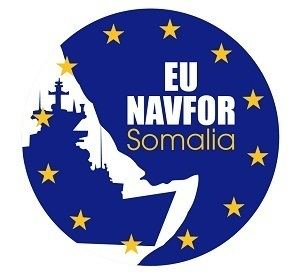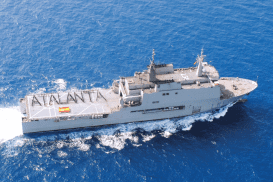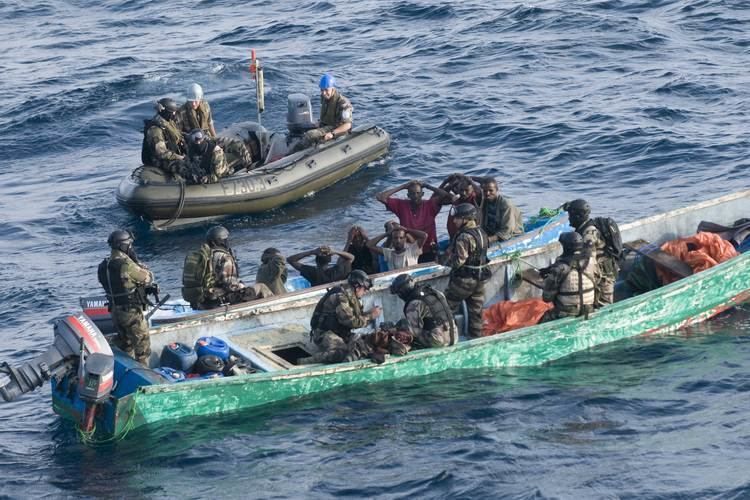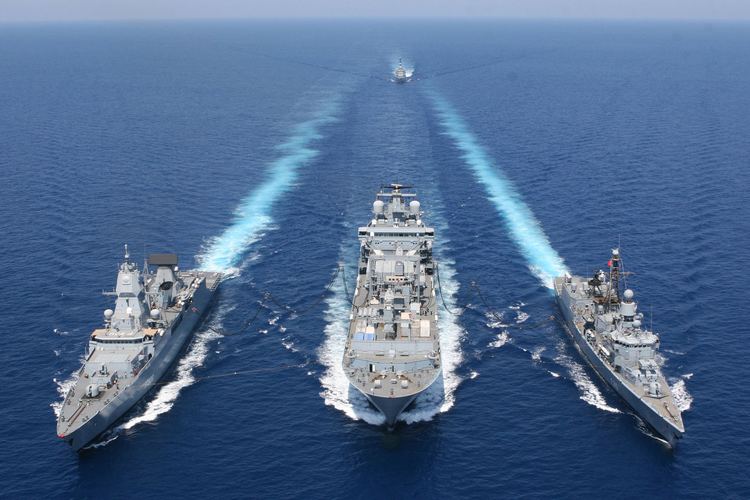Start date December 8, 2008 | ||
Similar Operation Ocean Shield, Operation Active Endeavour, Operation Enduring Freedom, Maersk Alabama hijacking, Action of 5 April 2010 | ||
EU NAVFOR Somalia, also known as Operation Atalanta, is a current counter-piracy military operation at sea off the Horn of Africa and in the Western Indian Ocean, that is the first undertaken by the European Union Naval Force. The operational headquarters is located at Northwood Headquarters in the UK.
Contents
- Overview
- Judicial international cooperation to end impunity
- Prelude
- Operational highlights
- Vessels
- Aircraft
- Vessels and aircraft in former rotation periods
- References

The mission launched in December 2008 with a focus on protecting Somalia-bound vessels and shipments belonging to the WFP and AMISOM, as well as select other vulnerable shipments. In addition, Operation Atalanta monitors fishing activity on the regional seaboard. In 2012, the scope of the mission expanded to include Somali coastal territories and internal waters so as to co-ordinate counter-piracy operations with Somalia's Transitional Federal Government (TFG) and regional administrations. On 16 July 2012, the EU also mandated the EUCAP Nestor mission to build up the maritime capacity of regional navies.

It is part of a larger global action by the EU to prevent and combat acts of piracy in the Indian Ocean. It cooperates with the multinational Combined Task Force 151 of the US-led Combined Maritime Forces (CMF) and NATO's anti-piracy Operation Ocean Shield.

Overview
Under EU Council Joint Action 851, which is based on various UN resolutions, Operation ATALANTA:

On 28 November 2016 the Council of the EU extended the Mandate of Operation ATALANTA until December 2018.
Located within the Headquarters of Operation ATALANTA is the Maritime Security Centre – Horn of Africa (MSCHOA), an initiative established by the European Union Naval Force, with close co-operation from industry. The MSCHOA centre provides 24-hour manned monitoring of vessels transiting through the Gulf of Aden, whilst the provision of an interactive website enables the Centre to communicate the latest anti-piracy guidance to industry and for Shipping Companies and operators to register their movements through the region.
Participation in EU NAVFOR goes beyond EU member states. Norway was the first non-EU country to contribute to the Operation, with a warship in 2009. Thereafter, Montenegro, Serbia and Ukraine have provided staff officers to the Operational Headquarters (OHQ) and Force Headquarters (FHQ). Ukraine contributed a warship early in 2014, and New Zealand contributed an MPRA asset later the same year.
Around 1,200 personnel are involved in ATALANTA, with the size of the force typically varying between 4–6 surface combat vessels and 2–3 Maritime Patrol Aircraft. For 2016, the budget will be €6.3 million for the common costs of the mandate.
Judicial international cooperation to end impunity
Piracy has to be undersood as organised criminal activity occurring at sea. It is organised on land, with kidnapping crews and ships for ransom as the business model. Prosecution of piracy suspects is a key component of the overall fight against piracy. The EU NAVFOR seeks, where possible, a legal finish. Transfers of suspect pirates for trial to competent authorities remain necessary to put an end to impunity in the Indian Ocean.
The EU is assisting the United Nations Development Programme (UNDP) and the United Nations Office for Drugs and Crime (UNODC) in their work to establish sufficient conditions to allow fair and efficient piracy trials in Somalia. The EU is the largest contributor to the UNODC counter-piracy programme. In the short term, transfers for trial from EU NAVFOR ships remain necessary to put an end to impunity in the Indian Ocean.
Prelude
The Transitional Federal Government of Somalia wrote to the President of the United Nations Security Council asking for international help to fight piracy and armed robbery against ships off the coast of Somalia. In June 2008, the Council unanimously passed Resolution 1816 authorising nations that have the agreement of the Transitional Federal Government to enter Somali territorial waters to deal with pirates. The measure, which was sponsored by France, the United States and Panama, was to last six months. France initially wanted the resolution to include other regions with pirate problems, such as West Africa, but were opposed by Vietnam, Libya and China, who wanted the sovereignty infringement limited to Somalia.
Operational highlights
On 2 January 2009, one of the Operation's ships captured eight pirates who were about to board a ship.
On 14 April 2009, the French frigate Nivôse attached to Operation Atalanta, captured 11 suspected pirates, together with their mother ship and two skiffs, in an EU NAVFOR focused operation carried out in the Indian Ocean. The French ship responded to the distress message by the 21,000 tonne Liberia flagged MV Safmarine Asia which came under small arms and RPG attack from two skiffs operating from a pirate mother ship. The warship deployed its helicopter, which quickly arrived on the scene, to deter the hijacking and shadow the mother vessel until the frigate arrived.
On 26 May 2009, the EU Naval Task Force vessel HMS Malmö responded to a distress call from the European cargo vessel M/V Antonis and apprehended seven suspected pirates.
From 5 to 7 March 2010, forces from France, Italy, Luxembourg, Spain and Sweden were in action; the French frigate Nivôse (F 732) secured its "biggest seizure" to-date in a vital shipping lane off the coast of Somalia, with 35 pirates arrested and four mother ships seized in three days.
In May 2010, there were a number of incidents in the area. The Russian destroyer Marshal Shaposhnikov freed the 106,474-ton MV Moscow University, which was about 350 miles east of Socotra, transporting crude oil from Sudan to China. Two days later, however, Russia’s Defense Ministry said it had proved impossible to establish the pirates’ citizenship or to establish legal grounds for prosecuting, therefore the pirates were returned to their boat and set free. In another incident, a Swedish aircraft attached to the EU Naval Force, the French warship Lafayette and the Dutch warship HNLMS Johan de Witt collaborated in the spotting and capturing of a pirate action group composed of a whaler and two skiffs, about 400 miles northwest of the Seychelles Islands. Reports on these incidents, citing other news reports, concluded that pirates were holding almost 20 vessels and about 300 crew members.
In September 2011, Marines from the SPS Galicia rescued the French citizen Evelyn Colombo. She had been kidnaped from a French yacht and her husband killed while trying to protect her.
In November 2012, Marines from the SPS Infanta Cristina liberated 21 Pakistani sailors from the trawler Al Talal, who had been kidnapped, detaining 9 pirates.
On 15 May 2012, EU naval forces conducted their first raid on pirate bases on the Somalia mainland as part of the operation, saying they 'destroyed several boats'. The forces were transported by helicopter to the pirate bases near the port of Harardhere. The attack was carried out overnight, and, according to the European forces, no local residents were hurt during the mission.
Vessels
The following vessels are part of EU NAVFOR's current fleet in Operation Atalanta, as of 24 February 2017. Operation Atalanta has the task force designator Task Force 465.
Aircraft
As of 11 April 2016 the following aircraft are currently deployed with the European Union Naval Force - Operation Atalanta.
Vessels and aircraft in former rotation periods
The following vessels have, among others, been committed to the Operation as of 11 April 2016.
